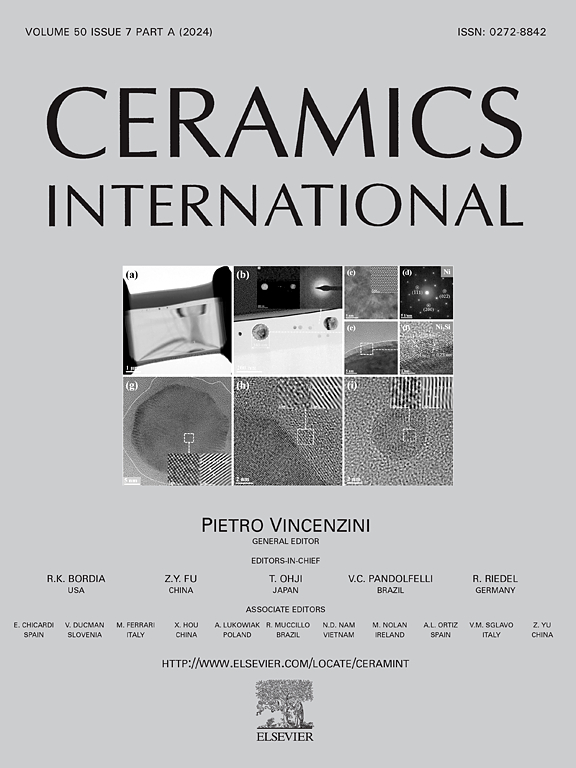TG-CVI致密多孔玻璃碳预制体制备GCF/PyC复合材料及表征
IF 5.6
2区 材料科学
Q1 MATERIALS SCIENCE, CERAMICS
引用次数: 0
摘要
采用模板法制备三维结构可调的碳泡沫。本文研究了模板含量对泡沫玻璃碳多孔结构、微观结构和力学性能的影响。采用热梯度化学气相沉积(TG-CVI)法制备了不同孔隙率的泡沫玻璃/焦碳(GCF/PyC)复合材料。致密化后,增加了泡沫玻璃的容重,修复了泡沫碳骨架的缺陷,提高了泡沫玻璃的力学性能,保证了泡沫玻璃的高导热性。随着孔隙率的增加,泡沫碳的抗压强度从83.03 MPa逐渐降低到24.52 MPa。所得GCF/PyC复合材料的抗压强度和抗弯强度先增大后达到峰值,然后减小。GCF1/1- c的最大抗压强度为120.5 MPa,最大抗折强度为92.21 MPa,分别比泡沫碳材料GCF1/1提高135%和267%。随着孔隙率的增加,泡沫炭的导热系数从1.22 W/m·K降低到0.75 W/m·K。GCF/PyC复合材料的导热系数先增大到4.41 W/m·K后减小,其中GCF2/1- c的导热系数最低,为3.26 W/m·K,比GCF2/1致密化前的导热系数提高了160%。本文章由计算机程序翻译,如有差异,请以英文原文为准。
Fabrication and characterization of GCF/PyC composites by TG-CVI densified porous glassy carbon preform
Carbon foams with adjustable three-dimensional architecture are obtained by template method. This paper describes the effects of template content impact on the porous framework, microstructure and mechanical properties of glassy carbon foams. Then a serious of glassy carbon foam/pyrocarbon (GCF/PyC) composites were fabricated by thermal gradient chemical vapor deposition (TG-CVI) using glassy carbon foam with different porosity as preform. After densification, bulk density of glassy carbon foam was increased and defects in carbon foam framework were repaired, which contributes to mechanical properties and ensures higher thermal conductivity. As the porosity increases, compressive strength of carbon foam gradually decreases from 83.03 MPa to 24.52 MPa. The compressive and flexural strengths of obtained GCF/PyC composites first increased and reached the peak values, then decreased. The maximum compressive and flexural strengths of GCF1/1-C are measured to be 120.5 MPa and 92.21 MPa, which are 135 % and 267 % higher than that of carbon foam GCF1/1. The thermal conductivity of carbon foam decreases from 1.22 W/m·K to 0.75 W/m·K with the porosity increase. For GCF/PyC composites, thermal conductivity first increases to 4.41 W/m·K then decrease, and GCF2/1-C has lowest thermal conductivity of 3.26 W/m·K among all GCF/PyC samples, which is 160 % higher than that of GCF2/1 before densification.
求助全文
通过发布文献求助,成功后即可免费获取论文全文。
去求助
来源期刊

Ceramics International
工程技术-材料科学:硅酸盐
CiteScore
9.40
自引率
15.40%
发文量
4558
审稿时长
25 days
期刊介绍:
Ceramics International covers the science of advanced ceramic materials. The journal encourages contributions that demonstrate how an understanding of the basic chemical and physical phenomena may direct materials design and stimulate ideas for new or improved processing techniques, in order to obtain materials with desired structural features and properties.
Ceramics International covers oxide and non-oxide ceramics, functional glasses, glass ceramics, amorphous inorganic non-metallic materials (and their combinations with metal and organic materials), in the form of particulates, dense or porous bodies, thin/thick films and laminated, graded and composite structures. Process related topics such as ceramic-ceramic joints or joining ceramics with dissimilar materials, as well as surface finishing and conditioning are also covered. Besides traditional processing techniques, manufacturing routes of interest include innovative procedures benefiting from externally applied stresses, electromagnetic fields and energetic beams, as well as top-down and self-assembly nanotechnology approaches. In addition, the journal welcomes submissions on bio-inspired and bio-enabled materials designs, experimentally validated multi scale modelling and simulation for materials design, and the use of the most advanced chemical and physical characterization techniques of structure, properties and behaviour.
Technologically relevant low-dimensional systems are a particular focus of Ceramics International. These include 0, 1 and 2-D nanomaterials (also covering CNTs, graphene and related materials, and diamond-like carbons), their nanocomposites, as well as nano-hybrids and hierarchical multifunctional nanostructures that might integrate molecular, biological and electronic components.
 求助内容:
求助内容: 应助结果提醒方式:
应助结果提醒方式:


